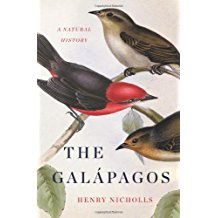The Galapagos: A Natural History, Henry Nicholls, 2014
A readable account of the natural history of the most famous island chain in the world. First visited by Europeans in 1532 when the Bishop of Peru was blown off course, settled in the early 1800’s by Ecuadorean entrepreneurs and settlers, and visited most famously by Charles Darwin on the HMS Beagle in 1835, this group of 4 inhabited islands (Santa Cruz, Isabela, Floreana, and San Crostobel) and several dozen others has been front and center in the study of evolution, volcanic geology (hotspots and tectonic plates moving over them), the impact of invasive species, and a realistic approach to conservation. The present 30,000 inhabitants and 200,000 annual visitors are learning to live in balance with the blue, red, and Nazca boobies, frigatebirds, flightless cormorants, and Galapagos penguins as well as the invertebrates, reptiles, and plants. Fond memories of our time there around New Year’s 2002.



